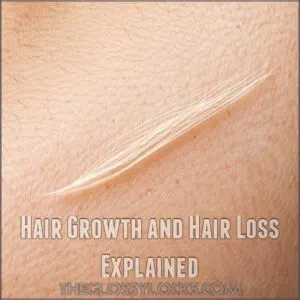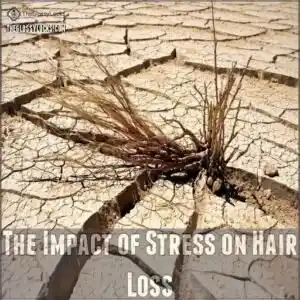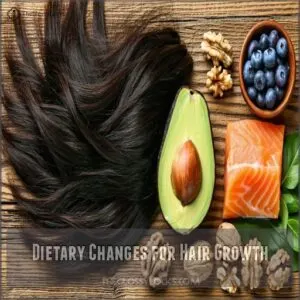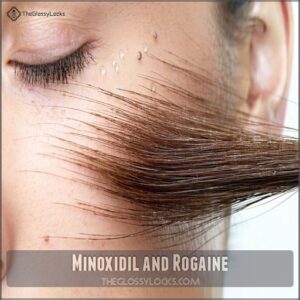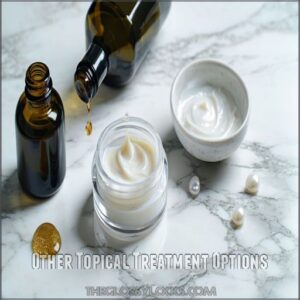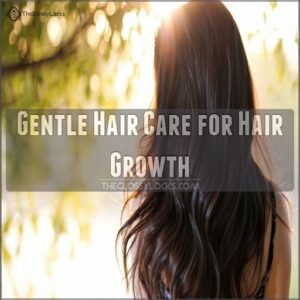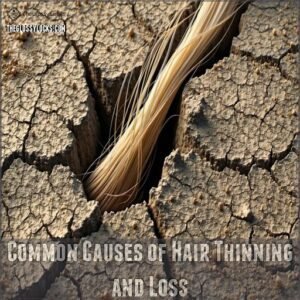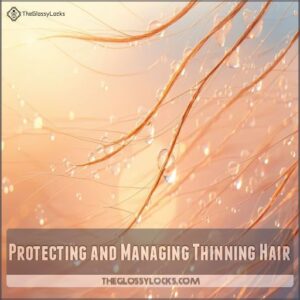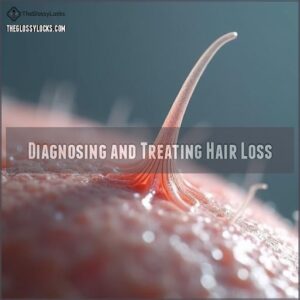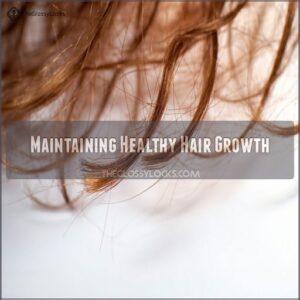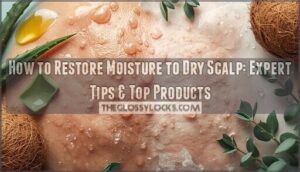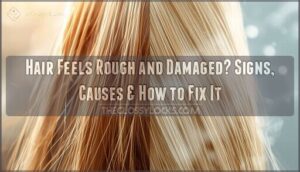This site is supported by our readers. We may earn a commission, at no cost to you, if you purchase through links.
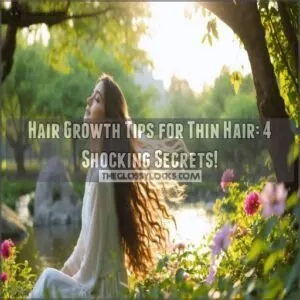
Stress less with mindful exercises like yoga, because high cortisol levels can seriously mess with your hair’s growth cycle.
Try topical treatments like minoxidil or rosemary oil to wake up those sluggish follicles. Even switching to gentle cleansers and avoiding heat tools can stop further damage.
And if genetics or hormonal shifts are at play, consult a pro for personalized solutions. Ready to achieve thicker, healthier hair? The right habits could make all the difference.
Table Of Contents
- Key Takeaways
- Hair Growth and Hair Loss Explained
- Reduce Stress for Healthy Hair Growth
- Dietary Changes for Hair Growth
- Top 4 Hair Growth Treatments for Thin Hair
- Using Topical Treatments for Hair Growth
- Gentle Hair Care for Hair Growth
- Common Causes of Hair Thinning and Loss
- Protecting and Managing Thinning Hair
- Diagnosing and Treating Hair Loss
- Maintaining Healthy Hair Growth
- Frequently Asked Questions (FAQs)
- What helps hair growth for thin hair?
- How do I grow my hair out if I have thin ends?
- Can thin hair be thickened again?
- What should you not use on thin hair?
- How to speed up hair growth after thinning?
- Is hair loss linked to vitamin deficiencies?
- Can hormonal birth control affect hair growth?
- Do hair growth supplements really work effectively?
- How quickly can hair regrowth be expected?
- Are hair transplants permanent or temporary solutions?
- Conclusion
Key Takeaways
- Focus on nutrient-packed foods like salmon, nuts, and leafy greens to nourish your hair from within and prevent thinning.
- Reduce stress with mindful exercises, such as yoga and meditation, as high cortisol levels disrupt your hair’s growth cycle.
- Use proven topical treatments like minoxidil or natural options like rosemary oil to stimulate follicles and promote growth.
- Practice gentle hair care by using sulfate-free shampoo, avoiding heat styling, and conditioning regularly to protect and strengthen thinning strands.
Hair Growth and Hair Loss Explained
Your hair naturally sheds up to 100 strands each day, but if you’re noticing more hair on your brush or pillow, you might be experiencing abnormal hair loss.
You’ll find the science-backed solutions you need here to understand what’s happening with your hair and take action to restore its natural thickness.
The Average Scalp and Hair Shedding
According to leading dermatologists, seeing strands in your brush isn’t always cause for alarm. Your Daily Hair Care routine naturally includes losing 50-100 hairs daily during the normal growth cycle.
With 85% of your Hair Follicles actively growing, these Hair Shedding Patterns maintain healthy Hair Follicle Health. Understanding Normal Hair Loss helps you spot changes – if hair shedding exceeds 100 strands, it’s time to monitor your scalp conditions.
For more information on hair loss patterns, recognizing the difference between normal and abnormal shedding is important for maintaining healthy hair.
Causes of Hair Loss and Thinning
Now that you know what normal hair shedding looks like, let’s unpack why your hair might be thinning.
Hair loss causes aren’t one-size-fits-all – they’re like puzzle pieces unique to you.
From hormone imbalance and genetic factors to nutrient deficiency and scalp health issues, your thinning hair could be sending signals about your overall health.
Understanding these hair thinning causes is your first step to finding thin hair solutions that work.
Understanding Androgenetic Alopecia
Beyond the various triggers of hair loss, androgenetic alopecia stands as the leading cause of thinning hair in both men and women.
Your hair follicles gradually shrink due to genetic factors and hormone imbalance, leading to noticeable hair thinning.
For women, FPHL typically starts with gradual thinning at the part line, while scalp health plays a key role in managing this common condition.
Researchers study hair loss treatment options to address androgenetic alopecia effectively.
Reduce Stress for Healthy Hair Growth
You’re losing more hair than usual because the stress in your life is taking a toll on your hair follicles.
If you’ve noticed extra strands in your brush or shower drain lately, don’t worry – you can fight back against stress-related hair loss with some simple lifestyle changes that’ll help your hair grow thicker and healthier.
Stress Reduction Techniques
Can’t focus because you’re stressed about your hair? Deep breathing and mindful exercises can work wonders.
Try scheduling 10 minutes daily for meditation benefits – start with guided apps if you’re new.
Yoga practice isn’t just good for your body; it’s a game-changer for managing emotional stress.
Mix these relaxation techniques with gentle walks, journaling, or whatever helps you unwind. Your hair will thank you.
The Impact of Stress on Hair Loss
Your high cortisol levels during stress directly affect your hair’s growth cycle.
When emotional stress or physical stress hits, your hair follicles can get stuck in a resting phase, leading to increased hair shedding.
This condition, called telogen effluvium, happens when stress effects push more follicles into their resting state.
By managing your emotional triggers through mindful relaxation, you’re not just calming your mind—you’re protecting your hair.
Dietary Changes for Hair Growth
You’ll be amazed at how simple changes to your diet can transform your thinning hair into thicker, healthier locks.
Your hair needs specific nutrients to grow strong, and you’re about to discover exactly which foods will give your strands the boost they’ve been craving for healthier locks.
Essential Nutrients for Hair Growth
Managing stress is just step one – now let’s power up from within.
Research shows that proper nutrient absorption plays a key role in hair health. A balanced vitamin intake, including vitamins A, D, and E, supports hair growth, while biotin and iron intake strengthen each strand.
Just remember – more isn’t always better with hair growth vitamins. Check with a doctor about the right mineral balance for you.
Foods That Promote Hair Growth
Want thicker hair naturally? Pack your plate with nutrient-dense powerhouses. Salmon’s omega benefits make hair fuller and reduce fallout, while nuts deliver protein and healthy fats that stimulate growth.
Legumes bring double the power – they’re packed with protein sources and hair growth vitamins. Incorporating the right foods to eat for ideal hair health can make a significant difference in hair thickness and overall appearance.
For a quick boost, add collagen to your morning coffee – studies show it enhances follicle health.
Avoiding Nutritional Deficiencies
Your hair’s health goes deeper than just what’s on your plate.
Recent research shows vitamin D, B12, and other micronutrients play a key role in preventing thinning hair.
Check your mineral balance through testing – iron deficiency anemia is particularly common.
Boost your vitamin intake with hair growth supplements, combining iron supplements with vitamin C for maximum absorption, and don’t forget protein sources and healthy fats.
Top 4 Hair Growth Treatments for Thin Hair
You’ll find relief from thinning hair with these proven treatments that boost growth and restore your confidence.
These top-rated products work together to nourish your scalp and strengthen each strand from root to tip, giving you the fuller, healthier hair you’ve been wanting.
1. Loreal Elvive Total Repair Balm
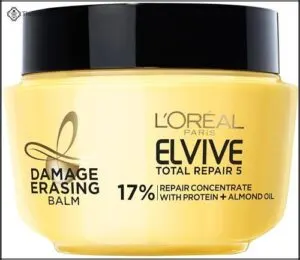
Looking for a game-changer in hair repair? L’Oreal’s Elvive Total Repair 5 Damage Erasing Balm packs a powerful punch with its 17% repair concentrate and almond oil formula.
Just slather it on after shampooing, wait 5 minutes, and rinse to see smoother, stronger strands. It tackles five major hair woes: split ends, weakness, roughness, dullness, and dehydration.
The sophisticated floral scent with green notes is a bonus, while the creamy texture won’t weigh down your locks. At $7.97, it’s a steal for salon-quality results.
Best For: Damaged, overworked hair needing a boost of repair and smoothing.
- Repairs and strengthens damaged hair, addressing split ends, weakness, roughness, dullness, and dehydration.
- Leaves hair smooth, shiny, and manageable without weighing it down.
- Pleasant, sophisticated floral scent with a touch of green notes.
- Jar packaging can be inconvenient with wet hands.
- Some users report inconsistent product seals.
- May not be moisturizing enough for extremely dry or damaged hair types as a standalone conditioner.
2. Milbon Hair Serum Treatment 7 oz
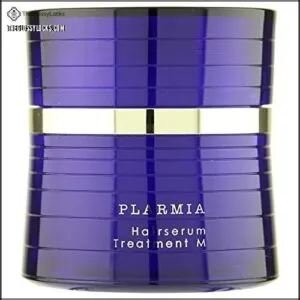
Regarding transformative hair treatments, Milbon’s 7 oz serum stands out as a powerhouse solution.
You’ll love how this Japanese-made serum nourishes and strengthens your strands while adding noticeable volume.
Despite its higher price point, a little goes a long way – users rave about its ability to repair damage from chemical processes and protect against heat styling.
The unscented formula plays well with other hair products, leaving your locks silky smooth and hydrated.
For best results, use it as a leave-in treatment or deep conditioner.
Best For: Those with damaged, fine, or dry hair seeking a salon-quality treatment for repair, hydration, and heat protection.
- Noticeably softer, smoother, and healthier hair after use.
- Effective as a leave-in treatment or deep conditioner.
- Repairs damage from chemical processes and heat styling.
- Higher price point, though a little goes a long way.
- While generally unscented, some detect a mild fragrance.
- Results may vary depending on hair type and individual needs.
3. Moroccanoil Restorative Hair Mask 85oz
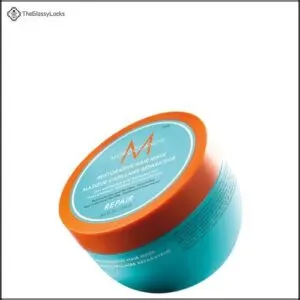
After just one treatment with Moroccanoil Restorative Hair Mask, you’ll notice a dramatic difference in your hair’s strength and shine.
This salon-quality mask, packed with argan oil, shea butter, and vegetable protein, works its magic in just 5-7 minutes without heat.
You’ll love how it repairs chemical and heat damage while rebuilding elasticity, and users rave about its luxurious scent and how it leaves hair silky smooth without feeling heavy.
Though it’s pricier at $45 for 8.5 oz, the results make it worth every penny.
Best For: Those with dry, damaged hair looking for a quick, effective deep conditioning treatment.
- Noticeably smoother, softer, and shinier hair after just one use.
- Repairs damage from chemical treatments, heat styling, and environmental stressors.
- Easy to use with a pleasant, luxurious scent.
- Higher price point compared to some alternatives.
- Jar can be slippery when wet.
- Some users find the results comparable to less expensive products.
4. SGX NYC Dry Texture Spray Refreshed Hair
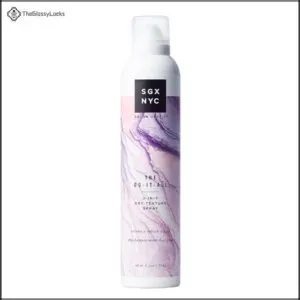
Looking to breathe new life into your thin hair? SGX NYC Dry Texture Spray works triple duty as a dry shampoo, texturizer, and hairspray.
You’ll love how this lightweight formula adds instant volume without any sticky residue. Whether you’re reviving second-day hair or adding oomph to freshly washed strands, its invisible formula delivers natural-looking body and texture.
Plus, it’s packed with UV protection and free from parabens and sulfates. The citrus-wood scent keeps your hair smelling fresh, while the vegan formula works for all hair types.
Best For: Those with thin or fine hair looking for a multi-tasking product to add volume, refresh, and style.
- Adds volume and texture without stickiness or residue.
- Offers UV protection and a refreshing citrus-wood scent.
- Vegan, paraben-free, and sulfate-free formula suitable for all hair types.
- Some reports of malfunctioning spray nozzles.
- Price point may be considered high for the amount of product.
- May not provide enough hold for those seeking a strong hairspray effect.
Using Topical Treatments for Hair Growth
You’ll find that the right topical treatments can make a significant difference in your hair growth journey, from proven solutions like minoxidil to promising natural alternatives.
Whether you’re dealing with thinning hair or just want fuller locks, these treatments work directly on your scalp to stimulate growth and improve the health of your existing strands, using proven solutions.
Minoxidil and Rogaine
You’ve likely heard buzz about Rogaine’s hair growth tips – and for good reason. While it wasn’t originally meant for hair regrowth, this FDA-approved treatment has proven effective for thinning hair.
Here’s what you need to know about minoxidil dosage:
- Takes 4+ months to see thicker hair naturally
- Must be used continuously to maintain results
- Can cause temporary scalp irritation when starting
Understanding the hair loss treatments is important for making informed decisions about your hair growth journey.
The key to success? Consistency and patience – you’ll need both to stop hair thinning.
Essential Oils for Hair Growth
Some essential oils may stimulate hair growth.
Rosemary oil, for example, can revitalize hair follicles, possibly rivaling minoxidil in effectiveness.
Tea tree oil and other oil blends, combined with scalp massage, may also promote natural hair growth and amazing hair growth, offering valuable hair growth tips.
Further research is needed to confirm these effects.
Other Topical Treatment Options
Beyond minoxidil and essential oils, consider these topical treatments for thinning hair:
- Hair serums containing growth boosters like follicle stimulators can nourish and strengthen hair.
- Scalp creams infused with hair growth supplements may improve follicle health and boost growth.
- Hair masks with growth-boosting ingredients provide deep conditioning and can stimulate hair follicles. Some hair growth products combine these approaches for best results.
Research on hair growth treatments has shown that consistent use can lead to significant improvements in hair density and overall health.
Gentle Hair Care for Hair Growth
You can encourage hair growth by treating your hair gently, minimizing breakage. This includes washing and conditioning carefully, as well as reducing heat styling and other damaging practices.
Gentle Hair Washing and Conditioning
Washing your hair right matters. Use a gentle shampoo, preferably sulfate-free, to protect your scalp’s health and prevent dryness.
Follow up with conditioner—starting at the ends—to lock in moisture and improve hair texture. A scalp massage during shampooing boosts circulation, which may support hair growth.
For more information on simple hair growth tips, incorporating these practices can lead to noticeable improvements. Build this into your hair care routine for healthier, stronger strands!
Minimizing Heat Styling and Damage
After a gentle wash, air-drying is your hair’s best friend.
If heat styling is a must, use heat protection methods and gentle hair tools. Lower the temperature on your tools and limit use to minimize hair damage and breakage, which is especially important for thinning hair.
Safe styling practices are key for healthy hair. Remember, less heat equals less damage and less hair breakage, which makes gentle hair tools essential for maintaining healthy locks.
Common Causes of Hair Thinning and Loss
Hair thinning can happen to anyone, and the reasons often come down to hormonal changes, genetics, or underlying health conditions.
Knowing what’s causing it’s your first step to finding the right solution.
Hormonal Changes and Imbalances
Hormonal changes can wreak havoc on your hair.
Menopause effects, cortisol levels from stress, or thyroid issues often lead to hair thinning.
Adrenal fatigue or unbalanced hormones might even slow hair growth entirely.
Female pattern hair loss can sometimes be treated with hormone therapy.
Chat with your doctor to rule out these sneaky culprits and take control!
Genetics and Androgenetic Alopecia
Genetics play a major role in hair thinning and male pattern baldness. Androgens interact with inherited traits, causing shorter hair growth cycles.
Here’s how genetics impacts you:
- Hormone imbalance: Variations in androgen receptor genes accelerate thinning.
- Hair follicle sensitivity: Follicles shrink, producing finer hair.
- Genetic testing: Predict your risk and response to treatments.
Control lies in early action.
Other Medical Conditions and Hair Loss
Sometimes, hair loss stems from sneaky medical culprits like polycystic ovary syndrome, iron deficiency anemia, and telogen effluvium. Disorders linked to hormones, androgens, or a total strain on the body often demand both health care and stress reduction techniques.
Here’s a quick comparison of conditions and symptoms:
| Condition | Common Signs | Linked Factors | Nutrition Role | Treatments |
|---|---|---|---|---|
| Polycystic Ovary Syndrome | Thinning scalp hair | Hormonal imbalance | Protein, iron intake | Hormone therapies |
| Telogen Effluvium | Sudden shedding | Stress/illness | Proper nutrients | Stress management |
| Iron Deficiency Anemia | Brittle, dull hair | Low iron levels | Iron-rich foods | Supplements/diet change |
| Androgenetic Alopecia | Gradual thinning | Genetics, androgens | Biotin, vitamin D | Minoxidil, hair transplant |
| Autoimmune Disorders | Patchy loss | Immune attack | Balanced diet | Medications, PRP therapy |
Protecting and Managing Thinning Hair
Taking care of thinning hair doesn’t have to be complicated, but it does require a little extra attention.
By sticking to gentle hair care practices and smart styling techniques, you can protect fragile strands and even make your hair appear fuller.
Hair Care Practices for Thinning Hair
Stopping hair thinning starts with a solid hair care regimen.
Use nourishing hair masks weekly for moisture and strength. Practice gentle combing to prevent breakage, and incorporate scalp massage with hair oiling to boost circulation.
Skip harsh products and embrace daily trimming to keep ends healthy. These hair care tips support thinning hair and encourage healthy, natural growth.
Styling Techniques for Thinning Hair
Boost thin hair with thoughtful styling! Opt for soft Hair Layering to add dimension, and embrace volumizers or dry shampoos for instant lift.
Hair Texturizing sprays work wonders for creating effortless body. Stick to Gentle Combing, avoiding tugging at delicate strands.
For extra flair, blow-dry roots for lift or try low-maintenance Thin Hair Styling with natural movement for everyday confidence.
Camouflaging Thinning Hair
A quick fix for thinning disguise? Try hair fibers or root coverage sprays to fill sparse spots fast.
Hair thickening products and color concealing powders work wonders—think of them as makeup for your scalp. Understanding hair fibers can also play a significant role in choosing the right products for your hair type.
Volumizers and strategic hair styling, like changing parts, add lift. For a finishing touch, hair mascaras can seamlessly stop hair thinning from stealing your confidence.
Diagnosing and Treating Hair Loss
If you’re losing more hair than usual, it’s time to figure out what’s causing it.
A doctor can run tests and recommend treatments, so you don’t have to guess or go it alone.
Consulting a Healthcare Provider
Sometimes hair loss needs more than a DIY fix. A doctor consultation sets the stage for targeted care.
They’ll evaluate:
- Symptoms to spot issues with your hair growth cycle.
- Different healthcare options, like medications or lifestyle changes.
- Specialist referrals, such as a dermatologist or hair specialist.
This patient evaluation reveals personalized hair loss prevention and treatment strategies.
Blood Tests and Medical Evaluation
Your doctor might recommend blood tests to figure out what’s behind your hair troubles.
Hormone testing and blood analysis can uncover health issues like thyroid disorders, anemia, or nutritional deficiencies.
These tests support a solid medical diagnosis, helping pinpoint causes of hair loss.
A health screening like this gives insight into your hair growth cycle and follicle health for better prevention and treatment.
Treatment Options for Hair Loss
When tackling hair loss, treatments depend on the cause.
From boosting growth to restoring thinning areas, here’s your toolbox:
- Minoxidil: Extends hair growth phases.
- Prescription meds: Finasteride or spironolactone address hormonal changes.
- PRP therapy: Uses your blood to stimulate follicles.
- Hair transplants: A surgical solution for severe cases.
- Low-level laser therapy: A high-tech option with variable success.
Maintaining Healthy Hair Growth
Keeping your hair healthy and strong takes consistent care, from regular trims to choosing products that nourish rather than damage.
By making small changes and staying mindful of your hair’s needs, you can encourage growth and avoid unnecessary breakage.
Regular Trims and Hair Care
Want thicker locks? Regular trims aren’t just about split ends—they keep hair healthy, encourage growth, and prevent breakage. Using a hair trimmer kit can be beneficial for maintaining healthy hair.
Stick to a proper hair care regimen with gentle washing, conditioning, and avoiding heat tools. Step 1 in hair loss prevention is consistency. Paired with stress reduction and good nutrition, it’s a solid approach to lower hair loss risk tied to androgenetic alopecia.
| Step | Action | Why It Matters |
|---|---|---|
| Trim every 6-8 weeks | Removes split ends before damage spreads | Keeps your hair strong and healthy |
| Use sulfate-free shampoo | Prevents dryness and protects natural oils | Maintains a healthier scalp environment |
| Condition regularly | Adds moisture and reduces frizz | Helps strengthen thinning hair |
| Limit heat tools | Lowers breakage and dryness | Makes thin hair appear fuller |
| Avoid tight hairstyles | Reduces tension on hair follicles | Lowers the risk of traction alopecia |
Monitoring Hair Growth and Adjusting Treatments
Keep up your hair care regimen by tracking progress.
Measure length monthly or snap consistent photos to spot changes.
Understand your hair growth phases to adjust treatment plans effectively.
If progress stalls, tweak routines with better products or strategies.
Progress monitoring isn’t complicated—it’s just smart.
Combine tracking with adjustment strategies to perfect those hair growth tips.
Avoiding Further Hair Damage and Loss
Keeping your hair healthy means getting serious about protecting it.
Skip tight hairstyles, stick to gentle combing, and avoid overloading with heat tools.
Focus on scalp protection by using sulfate-free shampoos and nourishing conditioners.
Understand your hair porosity to choose the right products for follicle care, which is key in hair loss prevention, and practice smart habits that prevent hair breakage and thinning.
Frequently Asked Questions (FAQs)
What helps hair growth for thin hair?
Imagine your scalp as fertile soil—nourishment is key.
Focus on iron– and protein-packed meals, gentle scalp massage to boost blood flow, and products like minoxidil or rosemary oil.
Stay patient; growth takes consistency and care.
How do I grow my hair out if I have thin ends?
Trim those thinning ends for fuller-looking hair as it grows, then pamper your scalp with gentle massages to boost circulation.
Nourish strands with deep conditioning treatments and a protein-rich diet to strengthen and reduce breakage.
Can thin hair be thickened again?
Can thin hair bounce back? Absolutely!
While genetics play a role, you can improve thickness with nourishing diets, scalp massages, and treatments like minoxidil.
Stick to gentle care and stress-busting routines for healthier, fuller strands.
What should you not use on thin hair?
Skip heavy conditioners and oils—they’ll weigh thin hair down and make it limp.
Avoid alcohol-based products that dry strands out, and steer clear of sulfates, as they strip natural oils, leaving your hair fragile and lifeless.
How to speed up hair growth after thinning?
Think of your scalp as soil—healthy roots grow with care.
Massage it daily, eat protein-rich foods, tackle stress, and try minoxidil or biotin.
Reduce breakage by avoiding heat tools and investing in gentle products.
Is hair loss linked to vitamin deficiencies?
Yes, lacking key vitamins like D, biotin, or iron can trigger hair loss.
Your hair thrives on nutrients, so a balanced diet or quick blood test can help pinpoint deficiencies and keep those strands strong!
Can hormonal birth control affect hair growth?
Imagine your hormones as a symphony; birth control can sometimes alter the tune, leading to hair shedding or thinning.
Some types may actually help balance hormones and improve growth, but it really depends on you.
Do hair growth supplements really work effectively?
Hair growth supplements can help if you’re deficient in key nutrients like biotin or iron, but they’re not magic pills.
Fixing diet gaps matters most, and always check with your doctor before starting supplements.
How quickly can hair regrowth be expected?
Rome wasn’t built in a day, and neither is hair regrowth.
With treatments like minoxidil, expect visible changes in 4-6 months.
For stress-related shedding, recovery may start in 6-8 months if triggers are managed.
Are hair transplants permanent or temporary solutions?
Transplants offer a permanent solution since they move healthy follicles to thinning areas.
However, existing weak hair can still thin over time, so maintaining results might require ongoing care or treatments to keep everything looking full.
Conclusion
Transforming thin hair into a fuller, healthier mane doesn’t have to feel like an uphill battle.
With these amazing hair growth tips for thin hair, you’re equipped to tackle the root causes of hair loss.
Nourish from the inside with the right foods, reduce stress, and embrace proven treatments like rosemary oil or minoxidil.
Remember, gentle care goes a long way in protecting your strands. Stick to these habits, and you’ll see real, lasting improvements over time.
- https://www.healthline.com/health/hair-loss-prevention
- https://medlineplus.gov/genetics/condition/androgenetic-alopecia/
- https://www.dove.com/us/en/stories/tips-and-how-to/hair-care-tips-advice/normal-shedding-vs-hair-loss-explained-by-a-dermatologist.html
- https://www.aad.org/public/diseases/hair-loss/causes/18-causes
- https://www.webmd.com/beauty/thinning-hair

